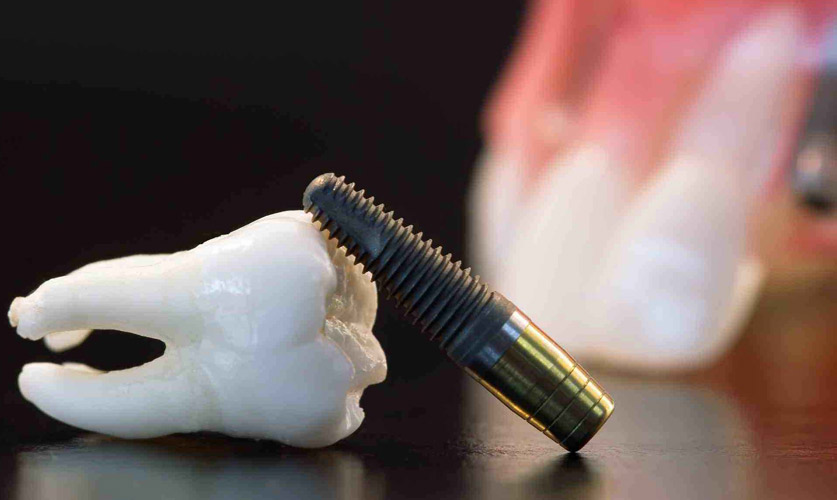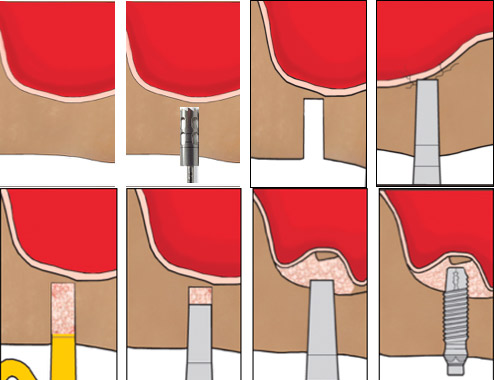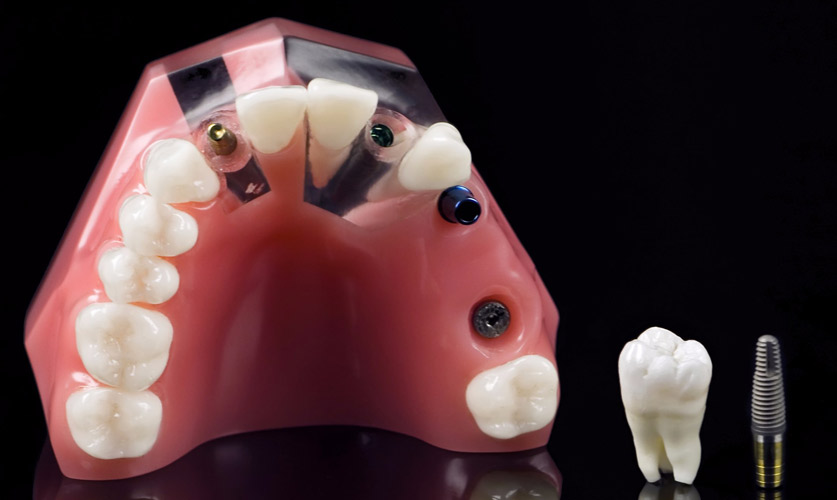MAXILLARY SINUS LIFT
Home »
A maxillary sinus lift is a surgical bone grafting technique linked to dental implant treatment. It involves a vertical augmentation of the bone available in the upper back area of the mouth. It is necessary to lift the floor of the maxillary sinus when it is not possible to insert dental implants in this area using conventional methods and the bone quantity must be increased before or during implant placement.
Maxillary sinus lift associated with dental implants
After losing a tooth, the bone tissue that once held it becomes atrophied and loses its volume over time. Moreover, when teeth are lost from the posterior maxilla area, the maxillary sinuses increase in size, further reducing bone availability. If the patient no longer has the bone quantity necessary when he or she wishes to receive a dental implant in the posterior maxilla, a sinus lift is a common solution with high success rates.
With a maxillary sinus lift, the professionals at our dental clinic in Valencia augment the bone tissue in the sinus cavity and provide the maxilla with the supporting bone quantity necessary to ensure implants are efficient and long-lasting.
Thanks to this procedure, patients at our dental clinic can resolve a lack of bone in the maxillary sinus and opt for dental implants.

Fill in our contact form if you would like to book an appointment at our dental clinic in Valencia:
Which techniques are used in a maxillary sinus lift?
There are several surgical techniques that may be used in a maxillary sinus lift. The technique selected will depend on the bone available initially.
When the bone shortage is a question of a few millimetres, the professional will perform an indirect or transcrestal sinus lift. This means that the increase in bone is performed using the same incision into which the implant will then be inserted. This is a quick and easy technique, which only takes 5-10 minutes longer than a standard implant procedure.

In contrast, when there is a notable shortage of bone, a direct or lateral sinus lift will need to be performed. In this case, after lifting the gum, a small window is opened in the lateral bone wall of the maxillary sinus using piezoelectric cutting instruments to avoid damaging the sinus membrane. This membrane is then lifted and position below the grafted bone before being stitched shut. This may sound quite intricate but this procedure does not bother patients. It is sometimes possible to place implants during the same procedure, but when the initial lack of bone is almost complete we will have no other choice but to wait six months from the sinus lift before inserting the implants in a second round of surgery.

This procedure can be undertaken using artificial bone graft materials or by combining these materials with the patient’s own bone obtained from neighbouring areas. In terms of artificial materials, these are biocompatible and osteoconductive. In other words, they are perfectly tolerated by the body and they guide new bone formation.

All maxillary sinus lift techniques are performed under local anaesthetic, meaning the operation will be totally painless and the patient will not require any special pre-operative preparation. This is a routine operation in clinics specialised in oral surgery and implantology, as ours is. The operation may cause some swelling in the treated area but this should go down in a day or two. As the sinus is connected to the nose, the patient may note a metallic taste of blood for a few days, as well as reddish-tinged mucus when blowing his or her nose. This is completely normal and there is no need to worry.
Implant placement at the same time as a sinus lift
As mentioned previously, it is often possible to insert dental implants during the same procedure as the sinus lift. Implant placement is possible when there is a lack of bone but not when it is non-existent: the patient must have a minimum bone height of 5 millimetres in order to provide the implants that are inserted during surgery with initial stability.

Durability of implants after a maxillary sinus lift
Implants inserted in areas where a maxillary sinus lift has been performed have the same guarantee as normal implants that are placed in areas with abundant bone. The only concern is having to wait four months following implant placement in order to create the support implant prosthesis, as opposed to two months for standard implants. This is because the grafted bone is initially weaker and we must wait until it is consolidated.
This procedure has given many patients at our dental clinic in Valencia the chance to confidently show off their dental implants.
Frequently asked questions about a maxillary sinus lift
-
Why is a maxillary sinus lift advised?
Treatment with dental implants is not possible if there is insufficient bone to accommodate them. Unfortunately, when we lose a tooth the bone that once held it is atrophied and loses volume. Furthermore, the maxillary sinus increases in volume, removing further bone available in the upper area of the upper jaw. A sinus lift is a bone grafting technique performed in the upper molar area in order to allow for dental implant placement in cases with little bone.
-
What does this procedure achieve?
A maxillary sinus lift procedure achieve bone height at the maxillary sinus in order to insert dental implants in the upper molar area in cases in which there is insufficient bone available.
-
What is the purpose of a maxillary sinus lift?
Patients who have insufficient bone tissue in the lost upper molar area need to increase this support so they may then accommodate dental implants.
-
What is the maxillary sinus?
The maxillary sinus is the largest of the four paranasal sinuses. The paranasal sinuses are anatomical cavities situated inside the cranium, which are covered in mucosa and which connect to the nasal orifices.
-
Is a maxillary sinus lift a painful procedure?
A maxillary sinus lift is a completely painless procedure carried out under local anaesthetic. It is a routine operation that we regularly perform on many patients in our specialised dental implantology clinic.
-
Is prior preparation necessary?
The professional will first perform a cone beam computed tomography (3D x-ray) in order to perform a detailed analysis of the maxillary sinuses. If sinusitis exists, this must be resolved before the procedure is carried out. A course of antibiotics, as indicated by the professional, is often sufficient. If this does not resolve it, the patient will be referred to an otolaryngologist, who is a doctor specialised in paranasal sinus pathologies, among other matters.
-
Do implants in areas subject to a maxillary sinus lift have the same durability?
A maxillary sinus lift does not affect that quality of the implants that are subsequently inserted and they maintain the same efficiency level as implants placed in healthy mandible areas. The only consideration to bear in mind is that, as they are positioned in grafted bone, they will initially be less stable. For this reason, following their placement, the patient must wait 3-4 months before the teeth are inserted, rather than two months which is the wait period for conventional implants.
Other treatments:
· Cavities and endodontics
· Cosmetic dentistry
· Paediatric dentistry
· Orthodontics
· Periodontics
· Dental prosthesis
· Digital dentistry
· Sleep apnoea



